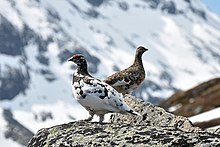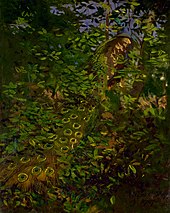
Hi Everybody!!
I am sure You notice in the image above that the hummingbird is green sitting on a peach tree branch that is also green. The tiny bird looks like a leaf! This is Natures Grand Design to camouflage the living creatures so they blend in with their environment for safe hiding in plain sight. Your infostudy from Wikipedia explains camouflage in Nature. Your photstudy of September 9, features the birds in trees. It is nice to capture them in the trees but they are very difficult to see. If these birds do no want to be seen, they will be very quiet and still. There could be a hundred in the trees, but You would never see one! If they move or make one of their noises, You can spot them hanging out. Below are a few entries from the Google Search Index regarding hummingbirds and camouflage. Once You learn to spot birds in trees, they will become easier for You to see. Happy Hunting (for photo ops) and Enjoy!


https://en.wikipedia.org/wiki/Camouflage
Camouflage
From Wikipedia, the free encyclopedia

Peacock Flounder shows its ability to change its pattern and colours to match its environment.
History[edit]
In zoology[edit]
In ancient Greece, Aristotle (384 BC – 322 BC) commented on the colour-changing abilities, both for camouflage and for signalling, of cephalopods including the octopus, in his Historia animalium:[2]
The octopus ... seeks its prey by so changing its colour as to render it like the colour of the stones adjacent to it; it does so also when alarmed.—Aristotle.[2]
Camouflage has been a topic of interest and research in zoology for well over a century. According to Charles Darwin's 1859 theory of natural selection,[3] features such as camouflage evolved by providing individual animals with a reproductive advantage, enabling them to leave more offspring, on average, than other members of the same species. In his Origin of Species, Darwin wrote:[4]
When we see leaf-eating insects green, and bark-feeders mottled-grey; the alpine ptarmigan white in winter, the red-grouse the colour of heather, and the black-grouse that of peaty earth, we must believe that these tints are of service to these birds and insects in preserving them from danger. Grouse, if not destroyed at some period of their lives, would increase in countless numbers; they are known to suffer largely from birds of prey; and hawks are guided by eyesight to their prey, so much so, that on parts of the Continent persons are warned not to keep white pigeons, as being the most liable to destruction. Hence I can see no reason to doubt that natural selection might be most effective in giving the proper colour to each kind of grouse, and in keeping that colour, when once acquired, true and constant.—Darwin[4]
The English zoologist Edward Bagnall Poulton studied animal coloration, especially camouflage. In his 1890 book The Colours of Animals, he classified different types such as "special protective resemblance" (where an animal looks like another object), or "general aggressive resemblance" (where a predator blends in with the background, enabling it to approach prey). His experiments showed that swallowtailed moth pupaewere camouflaged to match the backgrounds on which they were reared as larvae.[5][a]Poulton's "general protective resemblance"[7] was at that time considered to be the main method of camouflage, as when Frank Evers Beddard wrote in 1892 that "tree-frequenting animals are often green in colour. Among vertebrates numerous species ofparrots, iguanas, tree-frogs, and the green tree-snake are examples".[8] Beddard did however briefly mention other methods, including the "alluring coloration" of the flower mantis and the possibility of a different mechanism in the orange tip butterfly. He wrote that "the scattered green spots upon the under surface of the wings might have been intended for a rough sketch of the small flowerets of the plant [an umbellifer], so close is their mutual resemblance."[9][b] He also explained the coloration of sea fish such as the mackerel: "Among pelagic fish it is common to find the upper surface dark-coloured and the lower surface white, so that the animal is inconspicuous when seen either from above or below."[11]
The artist Abbott Handerson Thayer formulated what is sometimes called Thayer's Law, the principle of countershading.[12] However, he overstated the case in the 1909 book Concealing-Coloration in the Animal Kingdom, arguing that "All patterns and colors whatsoever of all animals that ever preyed or are preyed on are under certain normal circumstances obliterative" (that is, cryptic camouflage), and that "Not one 'mimicry' mark, not one 'warning color'... nor any 'sexually selected' color, exists anywhere in the world where there is not every reason to believe it the very best conceivable device for the concealment of its wearer",[13] and using paintings such as Peacock in the Woods (1907) to reinforce his argument.[14]
The English zoologist Hugh Cott's 1940 book Adaptive Coloration in Animals corrected Thayer's errors, sometimes sharply: "Thus we find Thayer straining the theory to a fantastic extreme in an endeavour to make it cover almost every type of coloration in the animal kingdom."[15] Cott built on Thayer's discoveries, developing a comprehensive view of camouflage based on "maximum disruptive contrast", countershading and hundreds of examples. The book explained how disruptive camouflage worked, using streaks of boldly contrasting colour, paradoxically making objects less visible by breaking up their outlines.[16] While Cott was more systematic and balanced in his view than Thayer, and did include some experimental evidence on the effectiveness of camouflage,[17] his 500 page textbook was, like Thayer's, mainly a natural history narrative which illustrated theories with examples.[18]
Crypsis[edit]
See also: Crypsis
Crypsis means blending with the background, making the animal or military equipment hard to see (or to detect in other ways, such as by sound or scent: for details, see crypsis). Visual crypsis can be achieved in many different ways,[1] which are described below.
Resemblance to the surroundings[edit]
Some animals' colours and patterns resemble a particular natural background. This is an important component of camouflage in all environments. For instance, tree-dwelling parakeets are mainly green;woodcocks of the forest floor are brown and speckled; reedbed bitterns are streaked brown and buff; in each case the animal's coloration matches the hues of its habitat.[67][68] Similarly, desert animals are almost all desert coloured in tones of sand, buff, ochre, and brownish grey, whether they are mammals like the gerbil or fennec fox, birds such as the desert lark or sandgrouse, or reptiles like the skink or horned viper.[69] Military uniforms, too, generally resemble their backgrounds; for example khaki uniforms are a muddy or dusty colour, originally chosen for service in South Asia.[70] Many[71] moths show industrial melanism, including the peppered moth which has coloration that blends in with tree bark.[72] The coloration of these insects evolved between 1860 and 1940 to match the changing colour of the tree trunks on which they rest, from pale and mottled to almost black in polluted areas.[71][c] This is taken by zoologists as evidence that camouflage is influenced by natural selection, as well as demonstrating that it changes where necessary to resemble the local background.[71]

Rock ptarmigan change colour in springtime; here the male is still mostly in winter plumage.
A Few Entries from the Google Search Index:
Hummingbird Nests - World of Hummingbirds .com
www.worldofhummingbirds.com › Hummingbird Nests
Hummingbird nests are very hard to spot because they are so small and so wellcamouflaged. Both animals and people can easily look right at a hummingbird ...
Do hummingbirds have a camouflage - WikiAnswers
wiki.answers.com › ... › Animal Life › Birds › Hummingbirds
Why are hummingbirds called Hummingbirds? Their wings beat (flap) so fast, they make a noise that sounds like humming. It's a bit like a higher note version of...
Hummingbird Nests/Eggs/Baby Hummingbird Pictures/Photos
howtoenjoyhummingbirds.com/hummingbird_nests.htm
Other hummingbird nest material includes bits of lichens that can be found on the outside of hummingbird nests for camouflage and the inside of the ...
Nesting Behavior of Hummingbirds - Wild Bird Store of Tucson AZ
www.wildbirdsonline.com/articles_hummingbirdnesting.html
I've found hummingbird nests camouflaged with tiny yellow flowers while a Palo Verde tree was in bloom. I was amazed to discover it, as I had passed by this ...
Hummingbird Nesting - A Bird's Home
www.abirdshome.com/hummingbirdnesting.html
Sep 12, 2013 - Such attention to detail created a nest that was camouflaged slightly differently on each side. Hummingbird House nests were camouflaged ...
*New Feature*
To view the extended photostudy, click on link below to go to my G+ Album with a slide show option:
Link:
https://plus.google.com/u/0/photos/117645114459863049265/albums/5927181942338201553

...this is brendasue signing off from Rainbow Creek. See You next time!

O+O




No comments:
Post a Comment
Hi Everybody! Please say hello and follow so I know you are here! Due to the inconsideration of people trying to put commercials on my blog comment area, I have restricted use of anonymous posts. Sorry that some hurt all.
My public email is katescabin@gmail.com No spammers or trolls